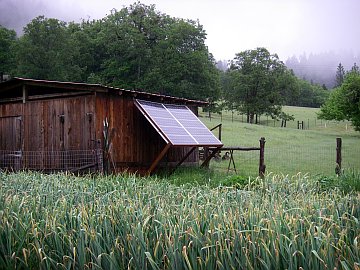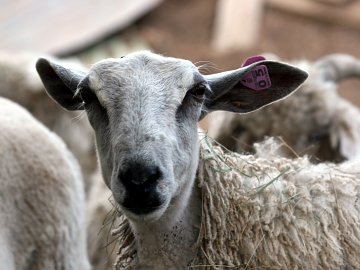~~* Black Sheep Newsletter............Issue 133............Autumn 2007 *~~
 †
†
THE HOMESTEAD: Another Well, Solar Pump and a Big Garden

The solar panels work even in overcast conditions
A harvest moon is on the rise
Yellow, gleaming, thrice its size!
Autumn breezes rustle leaves
(Time for gathering the sheaves)
Fall's around the corner...![]()
Corn in season, sweet on cobs
Tomatoes ripen, gobs and gobs!
Gathering food, fighting the clock!
(Before those winter skies unlock)
Yes, Fall's around the corner...![]()
Bucks in rut, this is the time
They seem to lose all reason, rhyme
Fix those fences, mend the gates!
(...as all of Nature procreates)
For Fall is here at last![]()
P.S. To my fellow angora goat raising friend in Kingman, Arizona who still has not suffered a hard frost in her garden – on September 23 we indeed had our first!![]()
Well, life on this homestead has been finding me busy as usual, maybe more so, due to it being harvest season and due to a wonderful, big garden filled with good produce. There is a pumpkin in the squash patch that is bigger than any I've ever grown before, and I'm hoping they'll have some kind of largest pumpkin contest in the local small town so I can show it off a bit. I blame my good fortune with an abundance of heirloom tomatoes turning red on the vine, a huge patch of corn that ripened to perfection and fat grapes dangling in rich purple bunches on the new well. More on this later.![]()
Before I go much further in my writing, I found out recently that some are really interested to find out if the salmon came back to Joe Hall Creek. So, I've decided here and now to make sure you all know that the coho did in fact return this past winter. We just never witnessed their return.![]()
They were sneaky in their return, perhaps hiding in the depths whenever our shadowy figures approached the creekside. We craned our necks and tried to find them, but no doubt they hid themselves well under the large logs that had been placed in the creek bed by the giant helicopter. So, though we all missed seeing the large salmon busily creating their nests, sure enough, judging by all the baby coho that appeared when spring sprung, they had come back another year.![]()
This past summer when it became hot and dry (how this land languishes in summer) my husband Stan along with the local fisheries biologist and a few select volunteers again donned their rubber suits and moved salmon fingerlings to larger and cooler bodies of water. It's always a slow and tedious process, moving those small fish, but a rewarding one. Our homestead creek (Joe Hall) just doesn't yet keep the big pools that are needed for the fish to survive, and in early to mid-August (two years in a row so far) they must be moved, bucket by bucket. The volunteers carry wands in their hands that electrocute the fish momentarily so that the fish fall flat and float in the water. It is during this short interim of time that the people "scoop" up the fish and place them carefully into their water buckets.![]()
Our hopes are that with time and nature's good will and cooperation, the pools in Joe Hall Creek will deepen and remain such (deep!) - especially as debris collects and lodges against the placement logs that were put into the creek a couple of Septembers ago (I wrote of this) – and the coho find that the pools of water are cool enough for their habitation, even over the hot summer months.![]()
It's all a waiting game for us, and we're hoping for a great outcome when it comes to bringing back the coho salmon forever. Perhaps and maybe someday we won't have to electrocute young fish and transport them elsewhere to accomplish our goals.![]()
"...And That Lucky Old Sun Has Nothing to Do...
...but ride around heaven all day." It's a line in an old song that I sometimes hum while in the garden only because we've been putting this Oregon sun to work all summer long. It's been chill in the mornings, but our late September days have been hot and dry. Today I'm watering a bed of deep orange and yellow nasturtiums whose leaf tips frosted only slightly two nights back.![]()
Our well drilling saga began with that large well drilling rig arriving on our place in late August 2006. If you've ever watched your own well being drilled, those huge bits surrounded by casing going deep, deep into your own ground, and waited and hoped for the well man to shout, "we've hit an artesian!" - then you know a bit of the excitement and trepidation we were feeling that morning.![]()

240 feet in rock-the new well
The morning began with a typical southern Oregon summer sky, vast and blue with the hint it would be another hot one, the sun unrelenting as it beat down upon our parched land. The men positioned the equipment and made the "x" where the drill would begin its noisesome drilling.![]()
Finally, with everything in place, the two men (with varying jobs to do) manned the large machine and the noise began. A grinding noise, loud with clanking sounds as earth and rock began to open up under the drill bit began to reverberate from our homestead. The noise, unabated except for the short time the men broke for lunch, continued for approximately 3 hours. 240 feet later we stopped the driller and said, "no more." By then my nerves were taut and I was a wreck. I'd been sitting on my overturned white plastic bucket under the oaks and watched the entire process. Stan's eyes met mine when the driller gave the ominous news that it looked like a gallon a minute, maybe a little bit more. He shrugged and said that was sometimes typical of wells around these parts and that we'd probably do just fine if we used holding tanks for our water.![]()
Of course wells can "open up" after being pumped and the driller said that could happen also, though he couldn't promise anything.![]()
How many years straight was the southern Oregon sun so scathing, so cruel, that it killed our every small attempt at gardening each year? We could get those early crops – the cabbages and the beets, the brocolli - our Oregon rains would handle those crops. Our hand dug well was also a help then. But it was the later crops that I missed. All the flowers blooming the entire summer long, the big squash and melons, tomatoes in abundance. The corn! I missed the corn so, a thirsty crop that I'd only planted once in our entire sojourn in Oregon (the first year we were here.)![]()
They capped the well that day and I went into the house and thought about it a bit dejectedly, I must admit.![]()
"Hey, we'll make do with this amount of water," Stan tried to assure me. "We have that 1,000 gallon holding tank. We pump water uphill to the tank and then gravity feed downhill – watering our gardens and trees using drip irrigation." It sounded good to me and I kept thinking 'who knows, maybe the well will open up...'![]()
We did some homework and found the submersible solar pump we wanted from an outfit in Arizona, and Stan exhumed the ten solar panels that we'd stored for all these years since moving from our off the grid Montana homestead to our current on-the-grid homestead in southern Oregon. We bought the poly pipe, 240 coiled feet of it and then purchased the 240 feet of insulated wiring necessary for deep wells. Yes, we could have gone with a less expensive system and pumped with electricity, but a crazy fanaticism took both of us over and we opted to go entirely solar.![]()
With all our supplies on hand, one morning Stan said, "OK, today's the day we get water pumping." We uncoiled 240 feet of poly pipe, stretched it for what seemed a half a mile across the dry land, and then began the slow process of lowering it into the well, with the shiny new pump secured to the pipe's end. Stan stood by the well; his job was to hold onto the heavy "pump end" and guide it into the well casing. I stood what seemed to be a mile away holding on for all I was worth to the other end of the poly pipe – and moved slowly an inch at a time forward. That black poly pipe slowly slid into the well and as it did water began to fill the pipe. Thus, that long pipe became heavier and heavier. Somehow we managed and held on tight. 230 feet later, the pump was in place (ten feet or so above the bottom of our new well) and it was ready to pump to the surface cool Oregon water.![]()
The first day we "tried it out" was one of those kinds of days that I call "once in a lifetime memory days". Since our new pump worked on both AC and DC electricity and we had not yet set up the solar panels, Stan chose to plug the system into an electric outlet. We stood next to the well housing and soon witnessed water gushing forth from the top of the pipe that stuck up out of the well. Water was flowing all over the dry Oregon ground! Our water! Our very own well water!![]()
We made the mistake of trying to taste it before it had totally "cleared up."![]()
"I taste salt, I think," Stan said as he screwed up his lips after drinking from a canning jar that he'd placed under the cold gusher.![]()
"The water is still foggy, a bit brownish," I answered. "Give it some time! I think maybe we are tasting some of the bleach the well guys poured into here..." That made sense to both of us, or at least we HOPED that was the case. Salt water wells were not an unheard of thing, but I recalled that the well guy tasted the water himself before he sealed the well and said it was "good." I again began to hope against hope...![]()
About an hour later, the water still pumping abundantly, it was apparent that it was now crystalline. "OK, now let's try it," he said. He put his canning jar under the cold flowing stream, filled it to the brim and then began to drink. A happy smile crossed his face. He handed the jar of crystal clear water to me. I drank with gusto, the sun glinting diamonds through the jar. "It's good water, honey!" I screamed with joy. Cool, clear water.![]()
Our garden flourished this summer. Each morning at about 8 am the sun would turn the pump on.
All day long, summer day after summer day, that lucky old sun was working with fury when unheeded by clouds. If cloud cover was there, the spray on the garden beds was a gentle one. I moved the waterer around the garden beds all day long. At about 7:00 pm, when the sun moved away from the panels (though there was still plenty of light) the fountains of the deep subsided. Finally at 8:00 pm I would see a slow trickle that often ebbed to a complete stillness. The water beads glistened on green grape leaves, and apples began to bulge with sweetness, making the branches on apple trees sag.![]()
The sun had done its job well, watering from morning until it retreated westerly and, as it left our sky entirely, it turned off the pump.![]()
An addendum: Yes, the well opened up! Amazingly the water pump never stopped pumping water all during the day. At this juncture we seem to be getting a good 3 to 4 gallons per minute of refreshing water. My favorite part of the equation is seen in the farm ledgers: we don't pay a penny to pump that water because solar power is FREE. How thankful this homesteader is!![]()
A New Ram
I've been speaking of water so much in this column that you may be thinking I'll next be talking of a water ram. Not so. I mean an actually sheep ram. The Black Sheep Gathering in late June was again a time to meet old friends and new ones as well as ogle gorgeous sheep and angora goats until my eyes were satiated. What was a bit different for me this past year was that I was in the "market" for a new ram.![]()
We raise the Suffolk sheep and have for years, the meaty sheep, the ones who fill our freezer to the brim with lamb chops and lamb roasts, but it was time to cull the old ram who was by now wanting to breed his daughters. No doubt, we needed a new ram. Stan left that to me since his job on the local Watershed Council was making time on the homestead rather scarce for him of late.![]()

Dalwhinnie, the new blueface ram
So, at the Gathering this year, I made it a point to stroll through the sheep aisles looking at various breeds of sheep. At one point I stopped dead in my tracks. That was when I fell instantly in love with a long wooled breed, the Blue Faced Leicester. What a fleece! The name fit, for their faces were indeed powder blue, but it was their incredible fleeces that first drew me closer to their pens. A hand spinner for life, I reached into one pen to finger the long, soft crimpy wool, to lift it into my hand, to touch its softness. The fleece was on a rather skitterish ewe who would rather be left alone, thank you, so I backed away.![]()
The next pen over had the card of a breeder from Roseburg, Oregon. Roseburg! Only an hour's drive or so from us! Her name was Debra Heinze and fate was with me that day that I took up her card. I put that card into my purse and vowed I would contact her soon. (And as usual meeting up with a fellow shepherd was really great; Debra is a weaver who makes good use of her sheep fleeces and colored angora goat fleeces. We had so much in common...)![]()
Fast forward to today: a fantastic young Blue Faced Leicester ram now struts his stuff around my Suffolk girls and they think he's really cute, to boot. They did the very first day he arrived, in fact, and he wasn't very shy of making his presence known. Trouble is that I want more! I'm now dead set on finding a couple of BF Leicester ewes, if only to raise the purebred lambs so that I can have an abundance of that super fine, super long creamy fleece in the coffers! Yes, I have spun many skeins of Suffolk fleece (believe it or not!) and even wove a nice blanket for my mom and pop (they love it!) with white Suffolk wool.![]()
Now that I have 705 Dalwhinnie on the farm (his name, purely Scottish in origin – she just called him "five" since he was a triplet) I'm already thinking of obtaining a Blue Faced ewe or two. Just a small beginning, you know. Mohair remains my fiber of choice, but Debra tells me that mohair mixed with this wool is awesome. What a magnificent blanket that might make...![]()
Alexandra Scribe
Homestead Home
TOP






